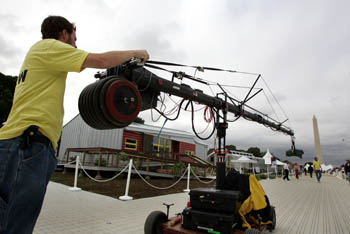
Solar Decathlon 2005
Photos of the Day
September 29-October 16, 2005
Click photo to view a larger image.
September 29, 2005
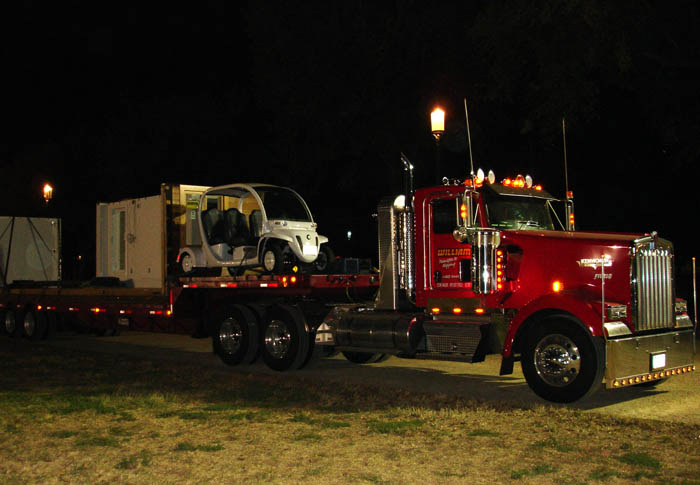
Soon after midnight on September 29, the trucks were allowed to enter the National Mall and the Solar
Decathlon construction zone. The trucks transported the solar homes the Decathlon teams constructed on
their respective campuses and then disassembled for transport. Teams have one week to reassemble their
homes on the Mall. This truck is carrying a disassembled Solar Decathlon home and a GEM electric vehicle
that will be used in the Getting Around
contest.
(Credit: Cécile Warner, NREL)
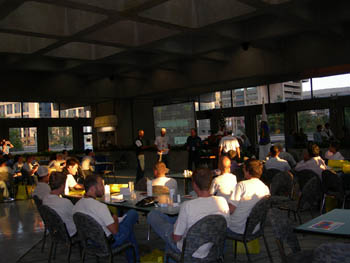
Weary students from the 18 Solar Decathlon teams attend the orientation meeting where Richard King,
Competition Director, outlines safety procedures and presents teams with the "Building Permits" for the
National Mall. Arriving at the Mall is another milestone in this project that has consumed their lives for
more than two years.
(Credit: Ivilina Thornton, NREL)
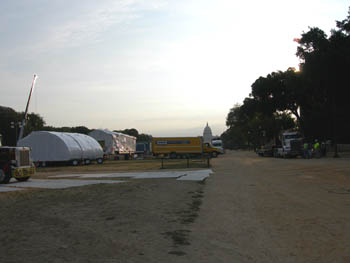
Dawn breaks on the 2005 Solar Decathlon. Overnight, the student teams have unloaded their solar houses
onto their building sites. Though the houses are still "under wraps," you can see the teams have employed
vastly different strategies to design the most attractive and energy-efficient solar-powered home.
(Credit: Ivilina Thornton, NREL)
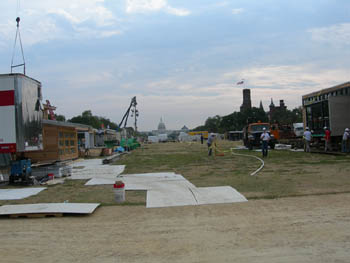
With the U.S. Capitol and Smithsonian Castle as a backdrop, the solar village is beginning to take shape.
The Solar Decathlon teams worked through the night to unload their trucks and "stage" the construction of
their solar powered homes. In one week, these 18 homes will be finished, complete with landscaping, wall
art, and solar electric systems that generate all the electricity a modern house needs.
(Credit:
Ivilina Thornton, NREL)
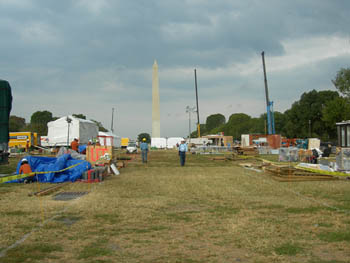
A forest of cranes competes for a view normally dominated by the Washington Monument early in the morning
of September 29.
(Credit: Ivilina Thornton, NREL)
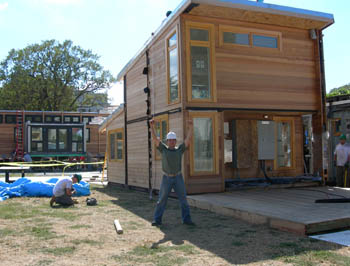
A New York Institute of Technology student still feels strong after working all night and into the
afternoon. The students' enthusiasm and energy is infectious. The modular design of these solar houses
allows them to be quickly reassembled onsite. The University of Maryland home is in the background.
(Credit: Wendy Butler-Burt, Department of Energy)
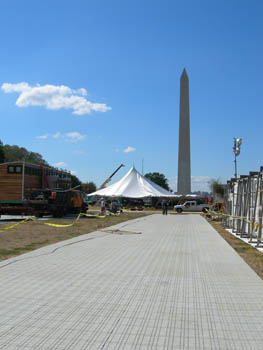
After the threat of rain and gusty conditions, the weather front passed through leaving a clear blue sky
and perfect home-building conditions. The main tent that will house educational exhibits and workshops is
going up and the "pavement" is going down. The temporary flooring helps protect the National Mall.
(Credit: Wendy Butler-Burt, Department of Energy)
September 30, 2005
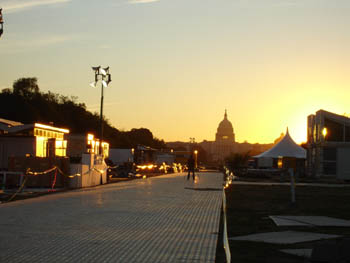
The sight of the U.S. Capitol, at any time of day, is inspiring. It's even more so when you are standing
in the middle of the Solar Decathlon solar village at sunrise. Day two of the 2005 Solar Decathlon dawned
with some student competitors having worked through the night — and their progress was apparent.
(Credit: Cécile Warner, NREL)
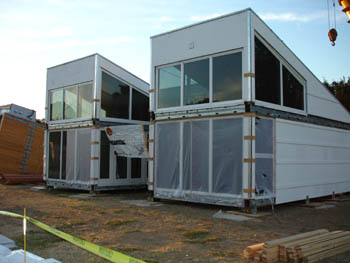
When the day shift of Solar Decathlon students and organizers left the solar village Thursday night, Florida International University's lot still was empty. But, by morning,
there it was — the house seemed to have grown from the ground overnight. The addition of the FIU
house to the village left only three empty lots: the Rhode Island School of
Design (the trucks carrying the house were on the Mall after overcoming very difficult shipping
challenges), Crowder College (the house is close to Washington, D.C.,
after several serious breakdowns on the road), and the lot where the "Anatomy of a House" exhibit will be
installed.
(Credit: Cécile Warner, NREL)
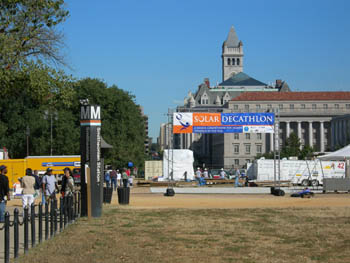
Anyone familiar with Washington, D.C., will find that this year's Solar Decathlon truly is in the middle
of everything. Look one way and you see the U.S. Capitol. Look the other way and you see the Washington
Monument. As you can see in this picture, the solar village will be right next to the Smithsonian Metro
station. In the background, you can see the Old Post Office building. This central location makes is easy
for anyone to come and see the amazing work of the students.
(Credit: David Crouch, Department
of Energy)
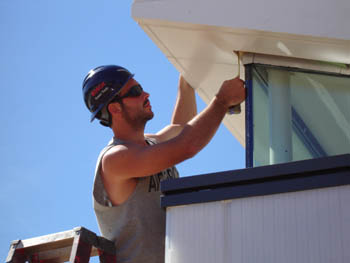
Today, many schools installed the roof on their respective houses. This is a major milestone in building
any house, but critically important in this competition because the roof is where the solar electric (photovoltaic system), will be housed. This student is working on the Virginia Polytechnic Institute and State University house, which also
was featured today in a Washington Post article that encouraged parents to bring their children
to the Solar Decathlon sometime in the next two weeks. The article emphasizes that the Solar Decathlon can
inspire students and adults alike.
(Credit: Cécile Warner, NREL)

Once the roof is in place, the students waste no time getting the photovoltaic (PV) systems installed.
The sooner they can get the system up and running, the sooner they can begin to generate electricity.
These PV systems are obviously critical to this competition, as they will supply all the energy needed for
the teams to compete in the 10 contests of the Decathlon. Here
students from the University of Colorado install their photovoltaic
panels on their roof.
(Credits: David Crouch, Department of Energy)
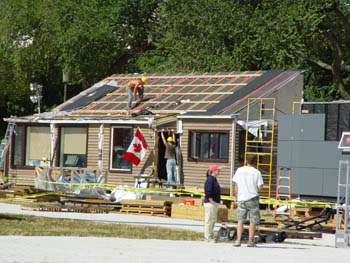
The Concordia University and Université de Montréal house is
designed with an optimal slope for housing the PV panels.
(Credits: David Crouch, Department of
Energy)
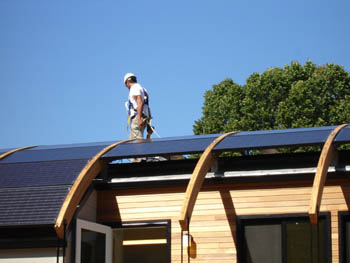
In the University of Maryland entry, the photovoltaics are an extension
of the home design. This concept of incorporating PV into a building's design in known as Building Integrated PV.
(Credits: David Crouch,
Department of Energy)
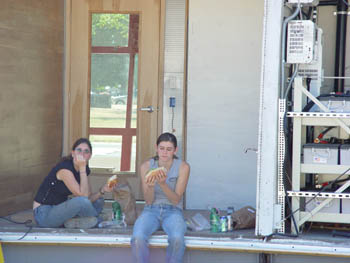
Although the students are frantically working night and day to reassemble their solar houses and apply
the finishing touches, they do make time to grab a quick lunch. Today, lunch was provided by Sprint, one
of the Solar Decathlon sponsors. Sprint is on site working hard to set up the network that will provide
Internet access for the students and transmit the Solar Decathlon scores and standings over the Internet.
Here, two students from the Pittsburgh Synergy team steal a few minutes
to refuel.
(Credit: David Crouch, Department of Energy)
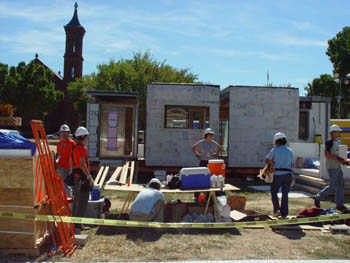
The students designed their houses so they could be reassembled incredibly quickly and efficiently,
knowing that they would only have a few days to finish their houses on the Mall. Here, the University of Texas at Austin team held a good old-fashioned "house raising."
A house now stands where just two hours before, only a foundation was visible.
(Credit: David
Crouch, Department of Energy)
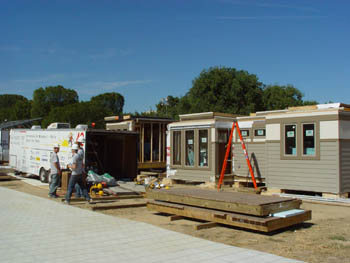
Similarly, the University of Missouri-Rolla and Rolla Technical Institute
house, seen in the foreground, arrived at the National Mall in three pieces. In just a matter of hours,
the team was able to reassemble the house, which is now far on its way to being complete.
(Credit: Wendy Butler-Burt, Department of Energy)
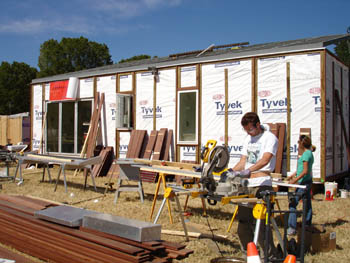
Having their roof in place, a portion of the University of Cornell team
turns their sites to cutting and installing siding for their solar house. The village was a flurry of
activity all day long, with the sounds of any typical construction site filling the air.
(Credit: David Crouch, Department of Energy)
October 1, 2005
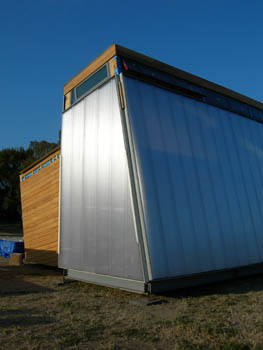
The early morning sun shines on the translucent north wall of the Pittsburgh Synergy house (Carnegie Mellon, University of Pittsburgh, and
the Pittsburgh Art Institute). This tilted wall is made of sheets of polycarbonate, a strong, insulating
plastic that is embedded with glass beads.
(Credit: Wendy Butler-Burt, Department of
Energy)

Recognized by his red Solar Decathlon "rules" shirt, Mike Wassmer discusses competition details with
University of Colorado team leader. Mike, a member of the University of Colorado's 2002 team, is now chair
of the 2005 Solar Decathlon Rules and Regulations committee, and is
employed by the National Renewable Energy Laboratory.
(Credit: Wendy Butler-Burt, Department of Energy)
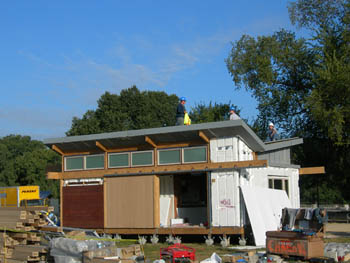
As early as yesterday, the Washington State University's house looked
like a giant Styrofoam cooler. Constructed of a new type of structural
insulated panel (SIP), the interior of the Washington State home is corrugated steel and the
polystyrene is on the outside. But as is clear in this photo, the polystyrene now is in the process of
being sheathed.
(Credit: Wendy Butler-Burt, Department of Energy)
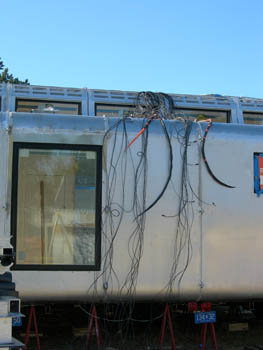
The University of Michigan's MiSo* (Modular Solar, Mass Produced and
Marketed) house is one of the more uniquely shaped homes in the Solar Village. The MiSo is designed to be
mass-produced to generate less waste. Today the MiSo house's complex technological systems are being
wired, which might look like an electrician's nightmare, but the sophisticated systems will help the house
perform exceptionally well.
(Credit: Wendy Butler-Burt, Department of Energy)
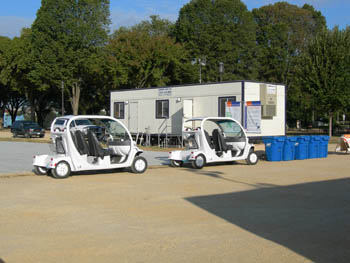
Easily the least attractive structure on the National Mall, the Solar Decathlon headquarters nevertheless
gets traffic as the "go to" place for any number of questions as can be seen by the line up of GEM
vehicles. The GEM vehicles are powered by electricity generated by the solar houses and are used in the Getting Around contest.
(Credit: Wendy Butler-Burt,
Department of Energy)

Having traveled the farthest distance to reach the National Mall, the Universidad Politécnica de Madrid team expected some difficulties,
but the team's house sustained far worse damage during shipment than anticipated. The house needed to be
repaired on site, and the team has been working three shifts per day to complete their home.
(Credit: Bob Burt)
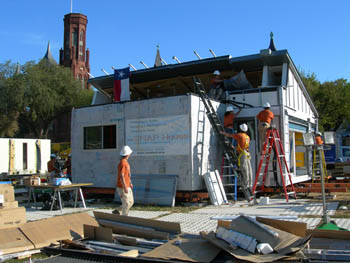
The phrase, "Pride of ownership apparent" is heard often when buying a home. The same is true on the
National Mall, and the students have begun showing their pride by hanging state and national flags. The University of Texas at Austin's Solar Decathlon SNAP House (Super Nifty
Action Package) blends natural beauty with cutting edge technology as team members have found many ways to
emphasize sustainable design.
(Credit: Wendy Butler-Burt, Department of Energy)
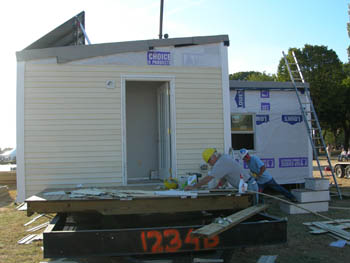
Washington, D.C., has been experiencing an unusually dry fall, which has presented perfect construction
weather for teams building their Solar Decathlon homes. But one dry weather problem for the teams has been
in installing ground faults in dry, hardpan soil. Here a ground fault is being drilled for the University of Massachusetts Dartmouth house, which, is being donated
to Habitat for Humanity after its debut on the National Mall.
(Credit: Wendy Butler-Burt,
Department of Energy)
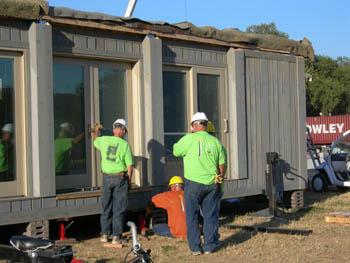
Every team now has its house on the National Mall! After experiencing major trailer failure (twice) and
being routed from Neosho, MO, to Washington, D.C., along many secondary roads, the Crowder College Solar Decathlon home arrived two days late. But team
members are making up for lost time and expect that their home will be ready for opening day.
(Credit: Wendy Butler-Burt, Department of Energy)
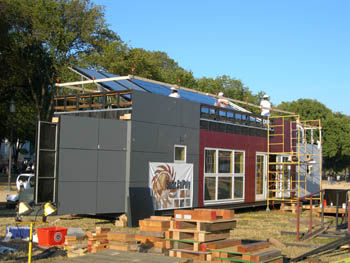
California Polytechnic State University's Solar Decathlon entry traveled
farther than any other American team. While this house, like many others in the competition, suffered some
damage along the way, the damage has been corrected.
(Credit: Wendy Butler-Burt, Department of
Energy)
October 2, 2005
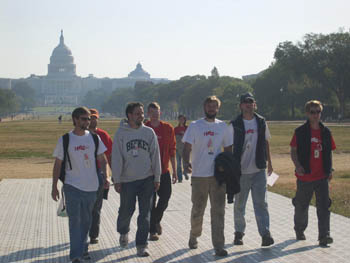
The RISD team rolls into the mall and heads toward their house early this morning to resume working after
a short night of sleep.
(Credit: Richard King, Department of Energy)

University of Missouri-Rolla students install solar panels in a roof integrated system they designed
themselves. Custom copper roof pans hold the thin film and the plumbing is integrated into the solar roof,
heating water and generating electricity from the same square footage.
(Credit: Molly Miller,
NREL)

CalPoly installs an awning on the front of their house. The awning is part of the team's passive solar
design strategy. The awning keeps summer sun out and allows winter sun in, and serves as a platform for PV
panels.
(Credit: Molly Miller, NREL)

Architecture student Andrea Read (left), and Interior Design student Lindsay Mellum work on Washington
State University's cabinets, made from Lyptus, a rapidly growing tree from Brazil. The team also
incorporated parallel strand lumber beams, made from a composite of smaller saplings. WSU is the only team
from the Northwest, and their design emphasizes conservation of timber, a major industry in their region.
(Credit: Molly Miller, NREL)
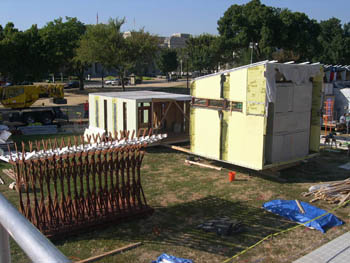
Pieces of the RISD house are being constructed separately, and will come together as the week goes on.
(Credit: Richard King, Department of Energy)
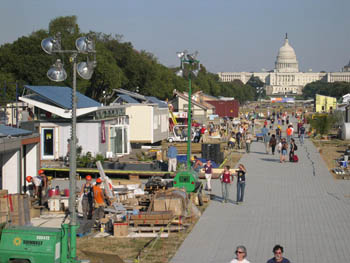
As shifts of students work around the clock, often using a 12 hours on 12 hours off schedule, the
construction progress is rapid. Curious onlookers pass through the village, walking on special flooring
that protects the grass on the Mall. The houses are still taped off with caution tape, and visitors will
have to come back when the competition officially opens in a few days.
(Credit: Richard King,
Department of Energy)
October 3, 2005

National Renewable Energy Laboratory's Ray Anthony arrives at the solar village for his shift. Anthony is
the nighttime safety officer for the event.
(Credit: Byron Stafford, NREL)
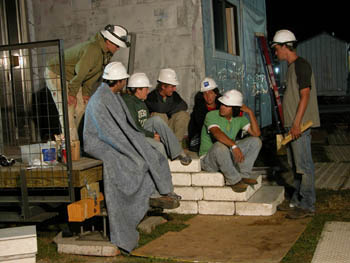
University of Texas at Austin team members confer late at night on their temporary stairs, a stack of
structural insulated panels (SIPs), from which the walls of their house are made. The wall behind the team
is made from reclaimed aluminum newspaper printing plates from the Daily Texan, the school paper. The
plates from recent editions serve as a time capsule as well as an example of reclaimed material.
(Credit: Byron Stafford, NREL)
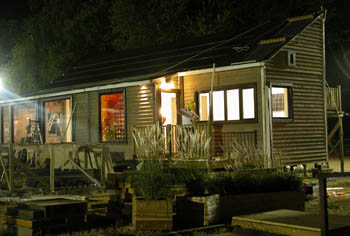
The Canadian Solar Decathlon worked through the night to bring their decks and ramps into compliance with
the American with Disabilities Act (ADA)—a requirement of the competition. Canada's home is fully
solar powered at this point in the assembly process. Small solar cells are integrated into the front
window, pictured, which is stenciled with colorful maple leaves. During the day, the window generates
electricity and transmits daylight, artfully splashing the colors of autumnal maple trees on to the
entryway floor tiles.
(Credit: Byron Stafford, NREL)
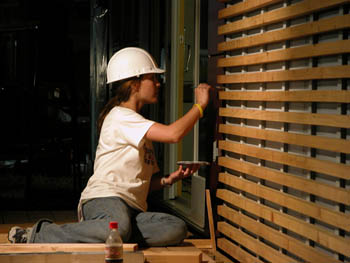
Michelle Hamilton, fifth year architecture student, does a late night paint touch up on California
Polytechnic University's redwood screen. The screen, made from redwood harvested in Santa Cruz,
California, just north of the CalPoly campus, has been certified as sustainably harvested by the Forest Stewardship Council. The screen will serve as a trellis and will
extend into a sunshade of the same material on the south side of the home.
(Credit: Byron
Stafford, NREL)
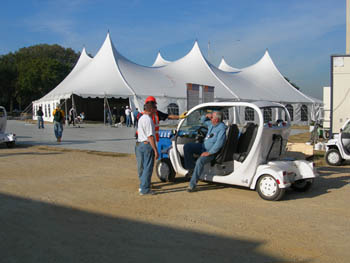
Department of Energy's Dan Eberle, contest official for Contest 10 Getting Around, arrived at the Village
main tent in a GEM electric vehicle.
(Credit: Molly Miller, NREL)
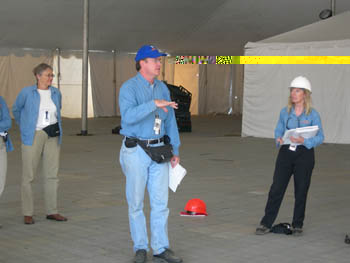
Competition director Richard King addresses representatives of each team at the morning meeting.
Competition project manager Cécile Warner stands to his right. Each morning the organizers of the
Solar Decathlon hold a 9 a.m. meeting in the main village tent to go over concerns and activities.
(Credit: Molly Miller, NREL)

Paul Norton, part of the instrumentation team for NREL, installs voltage taps for measuring the
electrical output of the PV systems.
(Credit: Ruby Nahan, NREL)
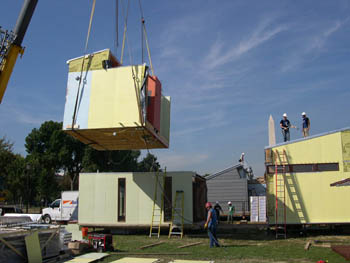
The third and final piece of Rhode Island School of Design's home arrives and is lifted into place.
(Credit: Byron Stafford, NREL)
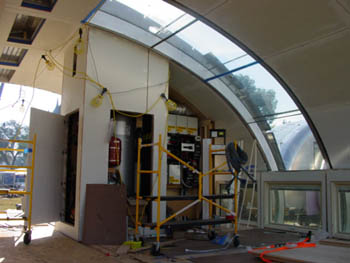
The interior of University of Michigan's home. Most teams are finishing their interiors at this point in
their preparation for the competition.
(Credit: Evan Miller, The Abo Group)
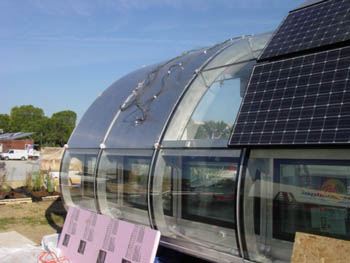
A shell around University of Michigan's home provides a space between interior and exterior for air
transfer.
(Credit: Evan Miller, The Abo Group)
October 4, 2005
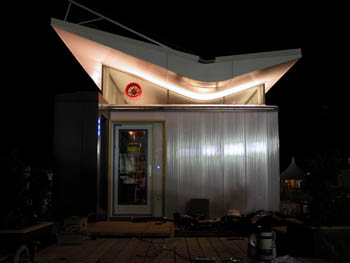
Lights running along the tops of the exterior walls of the home of the Virginia Polytechnic Institute and State University bounce light off
the roof. The PV system on the roof raises and lowers to reside within
the plane of the roof. The roof can also collect rain water.
(Credit: Byron Stafford, NREL)
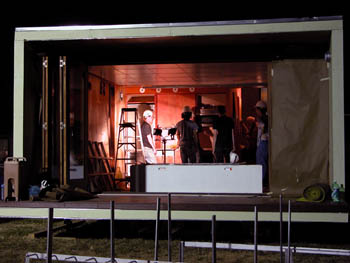
Rhode Island School of Design's sliding glass wall provides a night time
view of the team installing a thermal energy storage box. The box sits under the floor and is filled with
140 20x10x2 salt bricks also known as phase change materials. Copper
tubing runs from the box to radiant heating tubes that run under the ceiling tiles.
(Credit:
Byron Stafford, NREL)
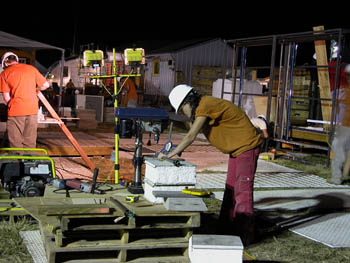
Danielle Pierananzi, University of Texas Sustainable Design major, drills a
hole for the late night installation of a ceiling fan. A former film student, Danielle is collaborating
with teammate and architecture student Sarah Hill on a documentary film about the building of the Texas
Decathlon home.
(Credit: Byron Stafford, NREL)
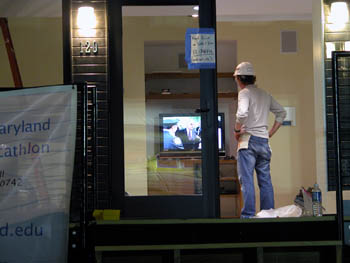
Maryland architecture student John Bryant catches a quick break while
team members run a late night test to determine the optimum position of their satellite TV dish, donated
by a sponsor. The team also checked the TV's energy load. Save for many small touches, Maryland has
completed assembly. The paint on the wall behind the TV is barely dry, and a warning sign is taped with
blue painter's tape to the front door.
(Credit: Byron Stafford, NREL)

Najahyia Chinchilla, Maryland architecture student, prepares kitchen walls and ceiling for a layer of
paint. Maryland's paint contains no volatile organic compounds. Energy efficient dimmable compact fluorescent bulbs will fit into the recessed light containers on
the ceiling.
(Credit: Molly Miller, NREL)

NYIT team construction manager Jerry Stramowski right and Green Machine team
leader Mike Catalano accept water from a water truck that delivered water to all the Decathlon homes on
the Mall Tuesday. Water is particularly significant to NYIT because the house will be partially powered by
a hydrogen fuel cell.
(Credit: Molly Miller, NREL)

Victoria, Maria, and Carolina of Madrid work on integrating plants into
the home's green roof. Flowering native plants on terraces and roofs are
a Mediterranean tradition, and in this case the plants are part of a bioclimatic strategy, serving to cool
the air around the rooftop PV panels and insulate the roof of the home's lounge.
(Credit:
Richard King, Department of Energy)
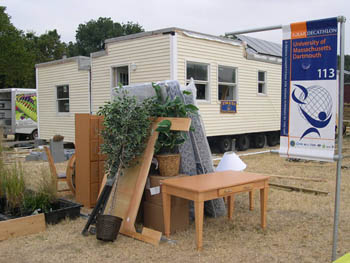
Furnishings are going into the homes a little at a time as assembly nears a final frenzied finish
tonight. The University of Massachusetts Dartmouth team partnered
early on with Washington, D.C., Habitat for Humanity. Habitat arranged for Americorps volunteers to work
on the house and ultimately the team will donate the house to Habitat.
(Credit: Richard King,
Department of Energy)
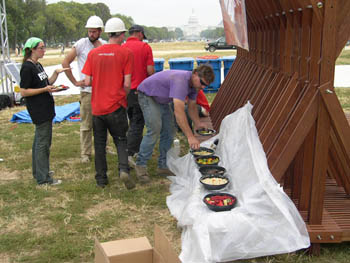
The Rhode Island School of Design finds yet another use for their shade
pavilion. The pavilion will shade visitors standing in line to tour their home, and will also hold exhibit
materials and educational signage about the house.
(Credit: Richard King, Department of
Energy)
October 5, 2005
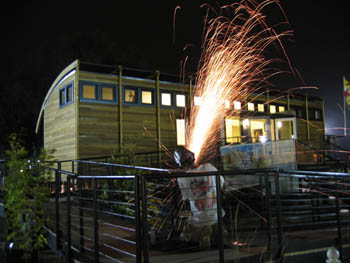
A contractor, in safety gear, installs metal railings for Maryland's
Americans with Disabilities Act (ADA)-compliant ramp. The contractor, Maryland Fabricators Inc, donated
equipment, materials, and labor.
(Credit: Paul Norton, NREL)

Tom Meyers, the competition's code inspector, discusses inspections with the Decathlon's fire marshal,
also his wife, Michelle. All of the houses in the competition must pass code inspections as well as
produce a viable fire safety plan.
(Credit: Richard King, Department of Energy)
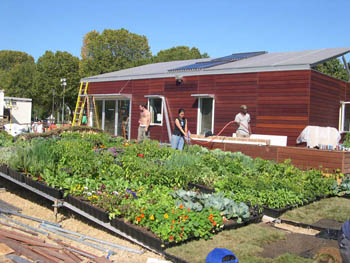
Cornell students Alex Lovallo, Maki Uchida, and Marc Miller work to
establish their team's ornamental and functional garden. The completely edible garden contains such
varieties as broccoli, kale, artichokes, eggplant, basil, and rosemary, and will be the ingredients for
team dinners throughout the competition.
(Credit: Richard King, Department of Energy)
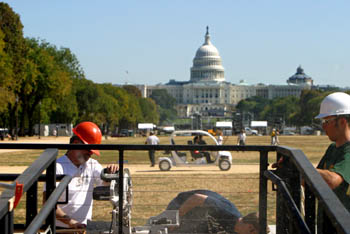
California Polytechnic's general contractor Richard Beller and team
member Austin Quig install wood and safety wires and on their ADA-compliant ramp.
(Credit:
Stefano Paltera, Solar Decathlon)
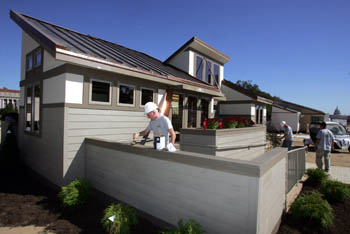
University of Missouri architectural engineering student Nick Bristow
paints trim on the team's house. The horizontal trim and horizontal banding throughout the house is meant
to invoke the Prairie School of architecture.
(Credit: Stefano Paltera, Solar Decathlon)
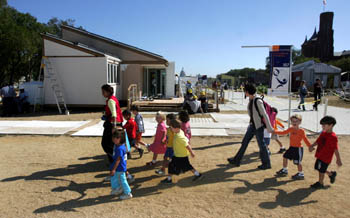
Young students from the Smithsonian Enrichment Center explore the activity of the solar village as they
traverse the Mall.
(Credit: Stefano Paltera, Solar Decathlon)
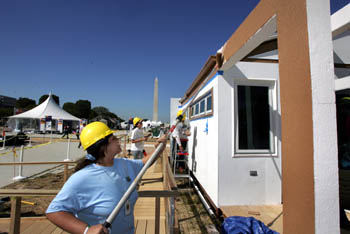
Universidad de Puerto Rico Business Administration major Keyla Torres
works to add earth tones and the occasional sky blue accents to the home's exterior room. The team chose
tropical colors in homage to their island home.
(Credit: Stefano Paltera, Solar Decathlon)
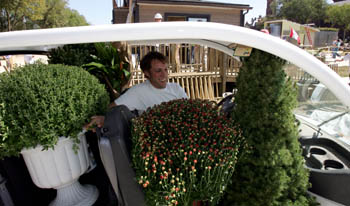
The Canadian team's Adrian Amorer brings a delivery of plants in the
school's electric vehicle. The vehicle is charged by the house.
(Credit: Stefano Paltera, Solar
Decathlon)
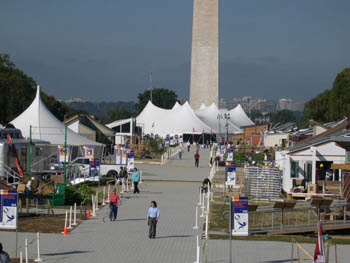
The village is starting to lose the feel of a construction site. Opening ceremonies take place Thursday
morning and dignitaries and sponsors will be showing up for private tours. Students will spend the night
on final touches and clean up.
(Credit: Richard King, Department of Energy)
October 6, 2005
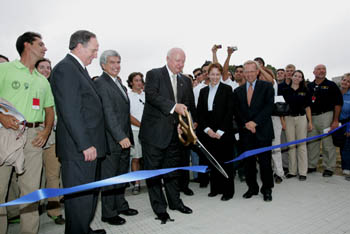
Let the competition begin! U.S. Secretary of Energy Samuel Bodman cuts the ribbon to open the solar
village at the 2005 Solar Decathlon.
(Credit: Stefano Paltera, Solar Decathlon)
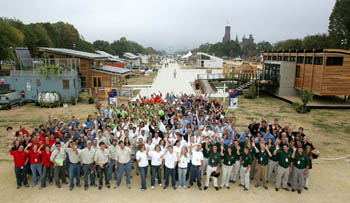
Here they are — the 2005 Solar Decathletes! Not even the misty Washington, D.C., morning can dampen
their spirits. Eight days of tough competition are ahead.
(Credit: Stefano Paltera, Solar
Decathlon)

A little spirit, please. The team from Puerto Rico adds to the
opening day festivities with flags, joyous songs, and tambourines. After all the hard work, it's great to
see the students having so much fun.
(Credit: Stefano Paltera, Solar Decathlon)
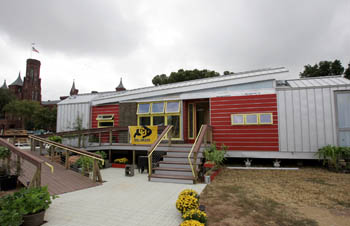
The University of Colorado house stands ready to receive visitors. In
the inaugural Solar Decathlon competition in 2002, the Colorado team took home top honors.
(Credit: Stefano Paltera, Solar Decathlon)
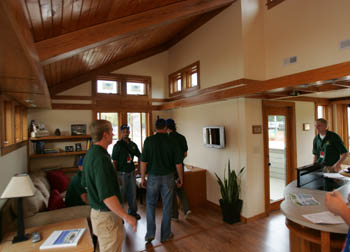
University of Missouri-Rolla students hang around home, finally finding a
chance to enjoy the fruits of their labor. The home features many built-ins that play off the designs of
Frank Lloyd Wright.
(Credit: Stefano Paltera, Solar Decathlon)
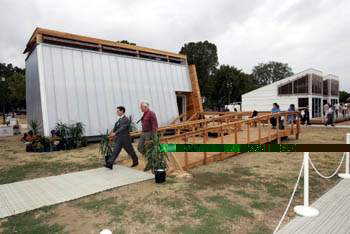
Pittsburgh's distinguishing feature is a completely translucent wall
for daylighting, which can also serve as a projection surface. The Florida
house, on the right, is built around a center courtyard. Modular walls and glass doors make it possible
for the entire space, including the courtyard, to become one large room.
(Credit: Stefano
Paltera, Solar Decathlon)
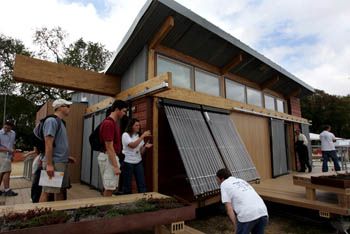
Washington State University team members show off their evacuated-tube
collectors for the home's solar hot water system.
(Credit: Stefano Paltera, Solar
Decathlon)
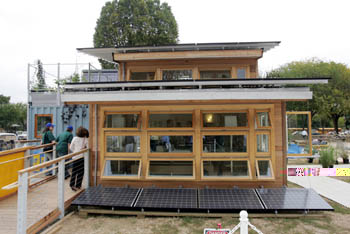
The west side of the New York Institute of Technology's house shows off
passive solar design features, operable windows that provide daylighting and breezes, overlooking the
active solar system.
(Credit: Stefano Paltera, Solar Decathlon)
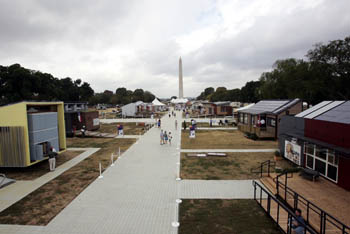
The solar village is quiet today, but just wait until tomorrow. That's the first day the houses are open
to the public.
(Credit: Stefano Paltera, Solar Decathlon)
October 7, 2005
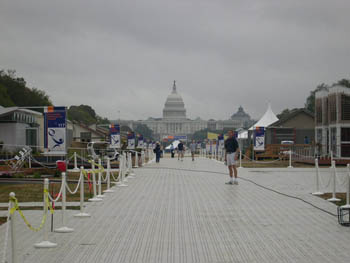
A rainy morning ushers in the first day of active competition at the Solar Decathlon.
(Credit:
Richard King, Department of Energy)
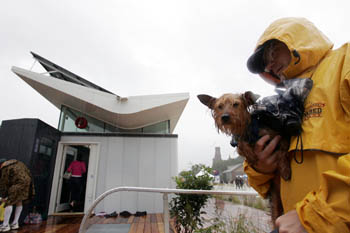
Many visitors, including both man and beast, came to see the houses despite the wet, gusty weather. The
Virginia Tech house is in the background.
(Credit: Stefano
Paltera, Solar Decathlon)
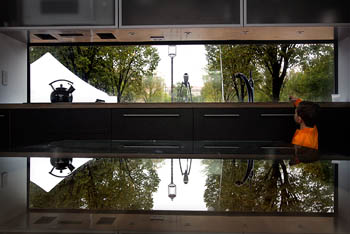
Perhaps this little boy is a Solar Decathlete of the future. Here, he looks out the kitchen window of Virginia Tech's house, with a table casting the reflection.
(Credit: Stefano Paltera, Solar Decathlon)
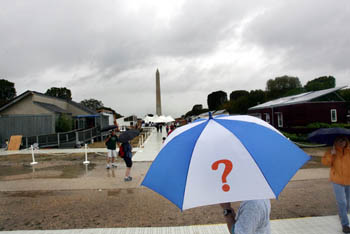
The weather is the big question mark today. All are hoping the sunshine returns tomorrow.
(Credit: Stefano Paltera, Solar Decathlon)
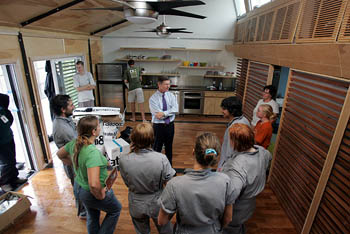
Congressman Lamar Smith of Texas stops by to wish good luck to the University
of Texas team.
(Credit: Stefano Paltera, Solar Decathlon)
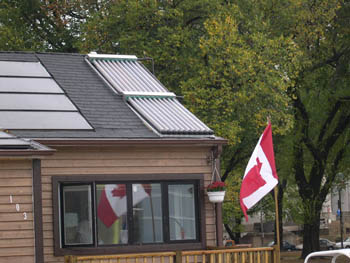
Team Canada proudly flies their flag, celebrating their entry in the Solar
Decathlon.
(Credit: Richard King, Department of Energy)
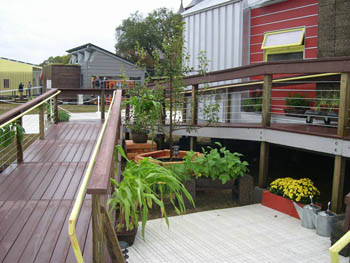
Many of the teams, including the one from the University of Colorado,
are adding curb appeal by landscaping with pots of flowers.
(Credit: Richard King, Department of
Energy)
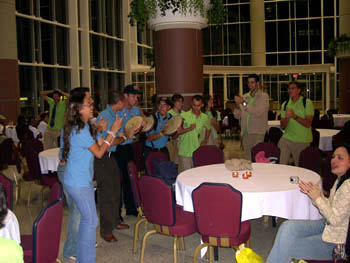
The teams from Spain and Puerto Rico
spearheaded a songfest during a reception sponsored by the National Association of Homebuilders.
(Credit: Richard King, Department of Energy)
October 8, 2005
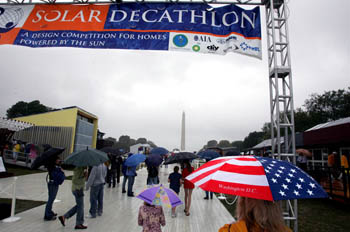
On this rainy Saturday at the Solar Decathlon, umbrellas are once again the order of the day. Hundreds of
visitors come to see the houses in spite of the wet weather.
(Credit: Stefano Paltera, Solar
Decathlon)
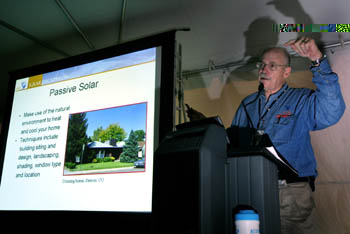
John Thornton of the National Renewable Energy Laboratory presents at a workshop titled "Solar Energy for
the Homeowner." Free consumer workshops are offered throughout the run of the Decathlon.
(Credit: Stefano Paltera, Solar Decathlon)
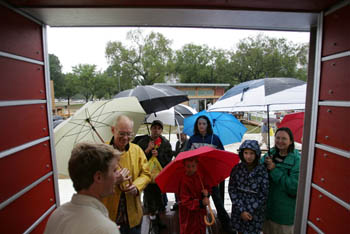
A student from the University of Colorado team encourages visitors to
enter the home.
(Credit: Stefano Paltera, Solar Decathlon)
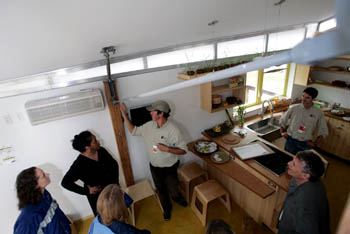
A Colorado student points out the home's unique roof system to visitors.
The roof can be jacked up or down two feet. This feature afforded the team an easier transport of the
house from Colorado to Washington, D.C.
(Credit: Stefano Paltera, Solar Decathlon)
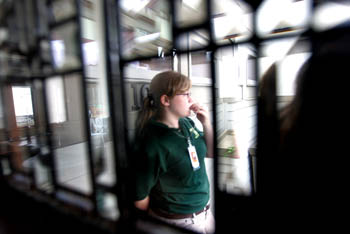
Natalie McDonald of the University of Missouri-Rolla and Rolla Technical
Institute team awaits the House Tour panel of judges.
(Credit: Stefano Paltera, Solar Decathlon)
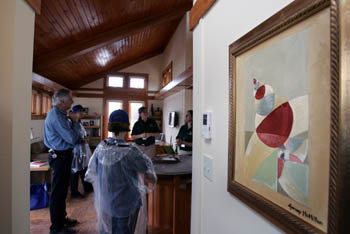
The House Tour panel of judges listen to Missouri students describe their home. The painting represents a mathematical
sequence known as the Fibonacci Sequence, or Golden Ratio, which can be found in most shapes and patterns
in nature, from pinecones to seashells. This concept guided the design of the home.
(Credit:
Stefano Paltera, Solar Decathlon)
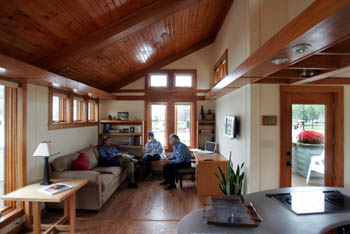
The House Tour judges confer on the experience of visiting the Missouri home. Interacting with visitors and pointing out the home's features
is one of the ten Decathlon contests.
(Credit: Stefano
Paltera, Solar Decathlon)
October 9, 2005
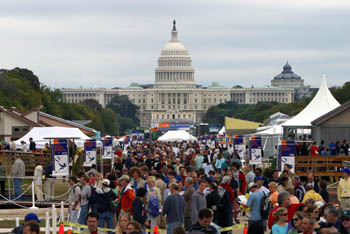
An estimated 20,000 to 25,000 people come to the Solar Decathlon today. They are curious about the houses
and eager to listen to the students.
(Credit: Stefano Paltera, Solar Decathlon)
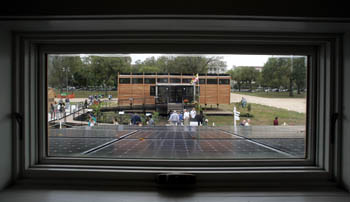
From inside the New York Institute of Technology house, the University of Maryland house is nicely framed.
(Credit: Stefano
Paltera, Solar Decathlon)
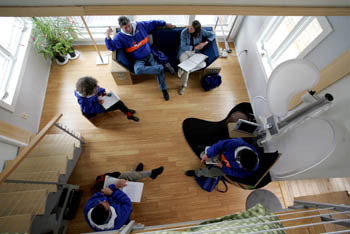
Members of the Architecture Jury discuss design features of
the New York Institute of Technology house. The jurors spend 30 minutes at
each house—20 minutes interacting with the students and 10 minutes in conference. No students are
allowed inside during the latter session.
(Credit: Stefano Paltera, Solar Decathlon)
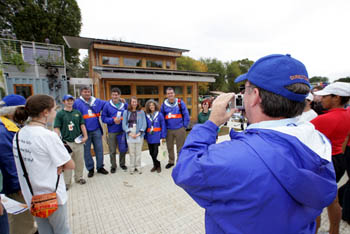
Lots of photographs are snapped at the Solar Decathlon. In this one, Decathlon Director Richard King
takes a shot of the Architecture Jury.
(Credit:
Stefano Paltera, Solar Decathlon)
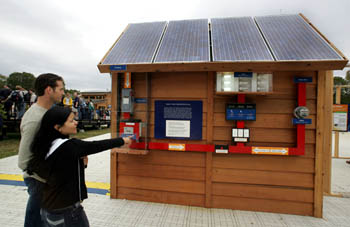
There are many exhibits at the Decathlon, including this one of a grid-tied solar electric panel.
Learning about solar energy has never been easier.
(Credit: Stefano Paltera, Solar
Decathlon)
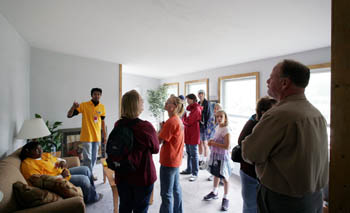
In the living room of the University of Massachusetts Dartmouth
home, visitors listen carefully to this student's description of various features of the house. Questions
are encouraged, and the students are excellent teachers.
(Credit: Stefano Paltera, Solar
Decathlon)
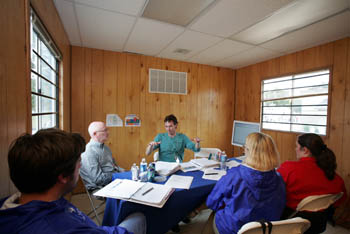
"Do Not Disturb. Jury Deliberations Underway." So reads the sign on the door where the Dwelling panel of judges deliberates.
(Credit: Stefano
Paltera, Solar Decathlon)
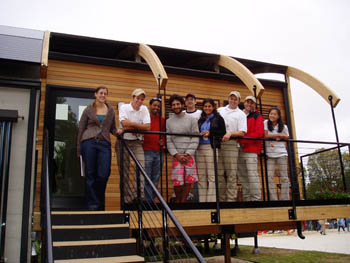
The new and old Maryland teams meet on the balcony of University of
Maryland house. 2005 Project Leader Rob Murray (second from left) and his counterpart from 2002,
Alex Yasbeck (fourth from left), find they have much in common.
(Credit: Wendy Butler-Burt,
Department of Energy)
October 10, 2005
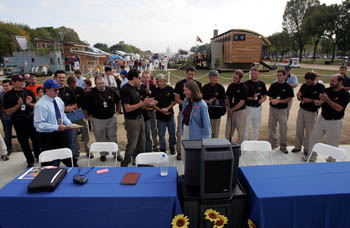
Solar Decathlon Director Richard King and Architecture
Panel Juror Sarah Susanka present the first place award for the Architecture Contest to Virginia
Polytechnic Institute and State University.
(Credit: Stefano Paltera, Solar
Decathlon)
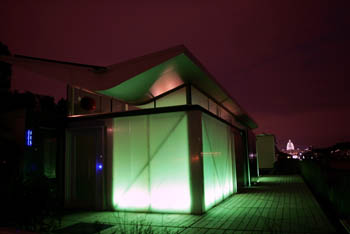
Virginia Polytechnic Institute and State University, winner of both
the Architecture and Dwelling
Contests, uses light as a design feature. In addition to being fully powered by solar electricity, the
home also has systems for collecting rainwater and gray water for planting beds outside the house.
(Credit: Stefano Paltera, Solar Decathlon)
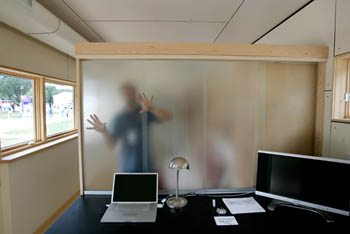
California Polytechnic State University took second place in both the Architecture Contest and the Dwelling Contest. Jurors on the Dwelling panel praised the house for its simplicity and elegant
divisions of interior space.
(Credit: Stefano Paltera, Solar Decathlon)
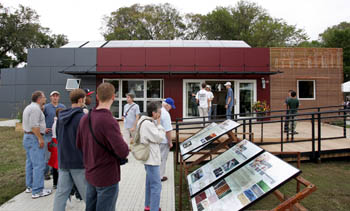
Visitors to CalPoly's home get a preview of its features on the
educational panels outside the home. A panel of Communications jurors evaluated how well the teams
communicate with the public about their homes.
(Credit: Stefano Paltera, Solar Decathlon)
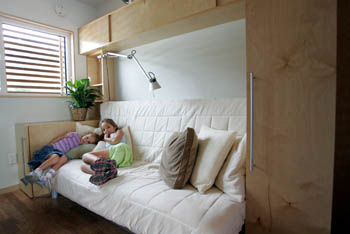
Young visitors to University of Texas, Austin's house get comfortable.
Texas tied wiith New York Institute of Technology (NYIT) for third in the Dwelling Contest. Dwelling
judges evaluate the livabiltity of the homes.
(Credit: Stefano Paltera, Solar
Decathlon)
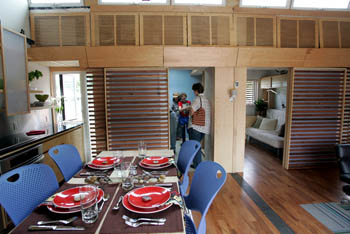
University of Texas installed mesquite floors in their home. Stones on the
kitchen table spell out SNAP. The team named the house SNAP house because the pieces of the home snap
together.
(Credit: Stefano Paltera, Solar Decathlon)
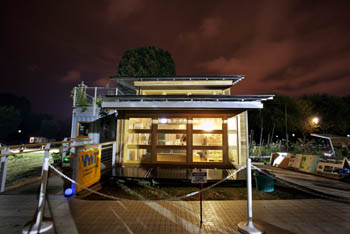
NYIT demonstrates solar power at night. NYIT tied with Cornell University for third place in the Architecture Contest.
(Credit: Stefano Paltera, Solar
Decathlon)
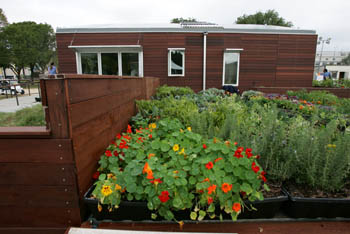
Architecture jurors were impressed with the way Cornell incorporated kitchen gardens into the home's sustainability
strategies.
(Credit: Stefano Paltera, Solar Decathlon)
October 11, 2005
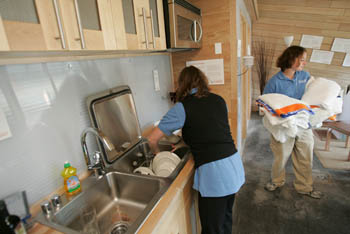
Pittsburgh Synergy prepares to participate in activities for the Appliances Contest. In the Appliances Contest, students must perform
a variety of energy consuming activities, including washing and drying 12 towels for 2 days and cleaning
dishes using a dishwasher for 4 days.
(Credit: Stefano Paltera, Solar Decathlon)

Students examine a compact fluorescent light bulb at the University of
Texas house. The Solar Decathlon's School Day brought about 450 students, ranging from third graders
to high school students, to see the Decathlon houses and exhibits.
(Credit: Stefano Paltera,
Solar Decathlon)
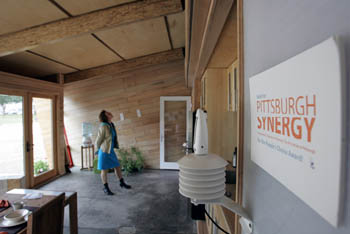
Communications jurors were impressed with Pittsburgh's logo and signage. Results from the Communications Contest were announced today, with University of Colorado taking first place.
(Credit: Stefano
Paltera, Solar Decathlon)
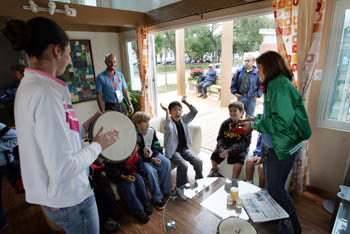
Universidad de Puerto Rico invited students from School Day into
their home. Puerto Rico placed second in the Communications
Contest in part for using effective techniques for public tours, such as playing drums and singing
for visitors waiting in line to enter the house.
(Credit: Stefano Paltera, Solar Decathlon)
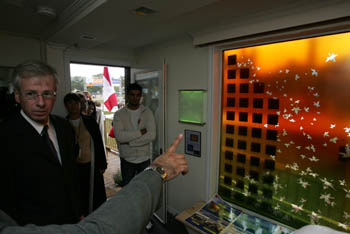
Canadian Minister of Environment Stéphane Dion paid a visit to the Canadian team's home today. The home features a PV window complete with
maple leaves.
(Credit: Stefano Paltera, Solar Decathlon)
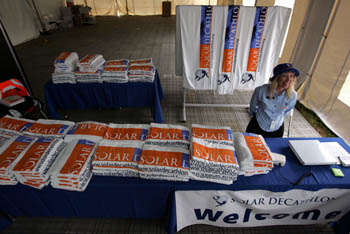
Decathlon Project Manager Cecile Warner distributes towels to students competing in the Appliances Contest. Organizers weigh towels before and after students
wash and dry the towels to be sure the towels are fully dry.
(Credit: Stefano Paltera, Solar
Decathlon)

A rain covered PV array on the University of Michigan house. The weather
has presented persistent challenges for solar energy generation in the solar village.
(Credit:
Stefano Paltera, Solar Decathlon)

The New York Institute of Technology team's dog, Zero—as in zero
energy house—hangs around her team's home, taking occasional naps next to the PV panels.
(Credit: Stefano Paltera, Solar Decathlon)
October 12, 2005
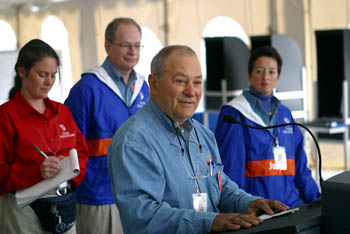
Lighting Panel judge Howard Brandston of the lighting design
firm Brandston Partnership Inc., announces the winners of the Lighting
Contest. Judges evaluated both daylighting and electric lighting.
(Credit: Stefano
Paltera, Solar Decathlon)
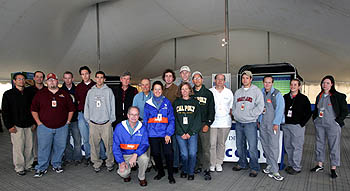
Winners of the Daylighting portion of the Lighting Contest gather for
a photo. University of Maryland and University
of Texas tied for third place. California Polytechnic State
University took second place and Virginia Polytechnic Institute
and State University won the contest.
(Credit: Stefano Paltera, Solar Decathlon)
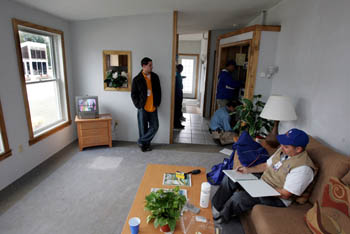
University of Massachusetts Dartmouth works with the contest's
Instrumentation Team, nicknamed iPod, to gather data for the Comfort
Zone Contest. Decathletes closed their houses to the public today in order to simulate temperature
and humidity conditions of a typical home containing about four people, rather than hundreds of visitors.
(Credit: Stefano Paltera, Solar Decathlon)
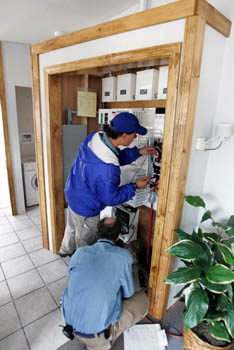
Decathlon's Instrumentation team takes temperature and humidity readings for the Comfort Zone Contest.
(Credit: Stefano Paltera, Solar
Decathlon)
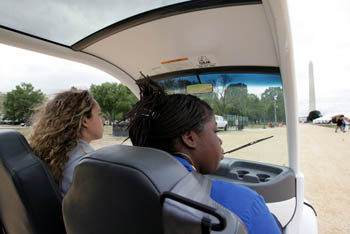
University of Massachusetts Dartmouth students log some miles on
their electric vehicle, which is charged by their house. The team that logs the most miles during the
competition wins the Getting Around Contest.
(Credit:
Stefano Paltera, Solar Decathlon)
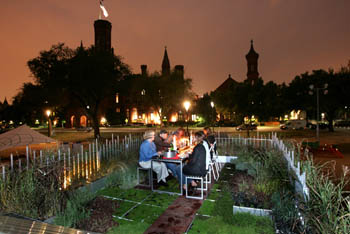
Rhode Island School of Design serves dinner on their rooftop garden in
candle light. To earn points in the Appliances Contest teams cook
and serve meals to contest officials for four days. The RISD students provide nice lighting during the day
as well, according to the Lighting Panel, which awarded them
first place in the Electric Lighting portion of the Lighting Contest.
Virginia tied with RISD for first.
(Credit: Stefano
Paltera, Solar Decathlon)
October 13, 2005
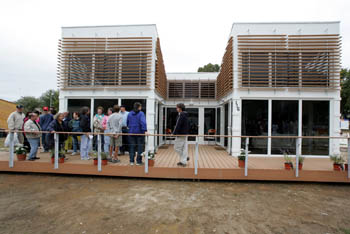
Despite the drizzly weather, crowds of people line up to tour Florida
International University's solar home, which is built around a courtyard. Sliding glass doors open
to allow the home to become one large indoor/outdoor room.
(Credit: Stefano Paltera, Solar
Decathlon)
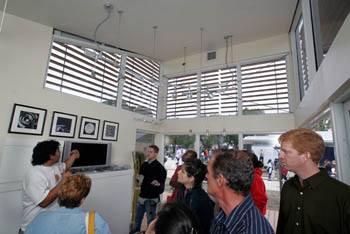
A tour guide from Florida International's team shows visitors around the
interior of the home, named Engawa, a Japanese term that describes space that is both inside and outside.
(Credit: Stefano Paltera, Solar Decathlon)
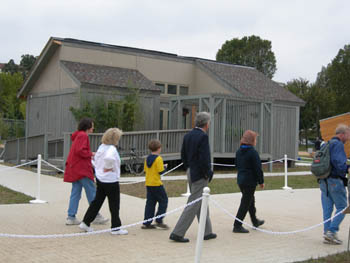
Just after the houses closed to the public for the day, visitors to the Mall check out Crowder College's Arts & Crafts style solar home.
(Credit:
Molly Miller, NREL)
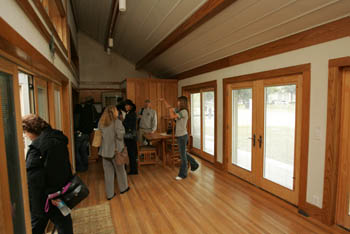
A Crowder team member shows a public tour around the interior of the
home. Flooring, trim and cabinetry in the house is made from hardwood from the Pioneer Forest in the
Ozarks.
(Credit: Stefano Paltera, Solar Decathlon)
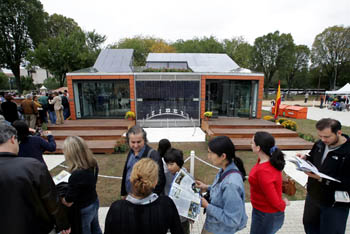
Long lines form outside Universidad Politécnica de Madrid's house,
known as Magic Box. Madrid's home is clad in clay tile and incorporates a collapsible interior courtyard,
a green roof, and a sun dial.
(Credit: Stefano Paltera, Solar Decathlon)
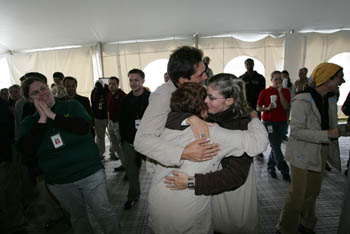
Madrid students react to the announcement of awards for the Documentation Contest in which they placed second. For this
contest, jurors evaluate the quality of the teams' documentation of all stages of their projects,
including the design process for the homes and energy systems.
(Credit: Stefano Paltera, Solar
Decathlon)
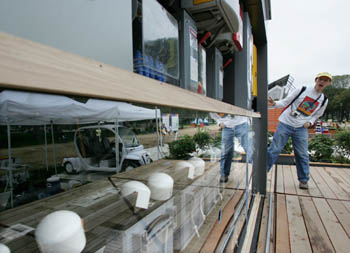
A visitor to the Virginia Polytechnic Institute of Technology is
amazed to see the battery bank which stores the home's solar energy. The home's batteries charge the
team's electric car, visible in the reflection.
(Credit: Stefano Paltera, Solar Decathlon)
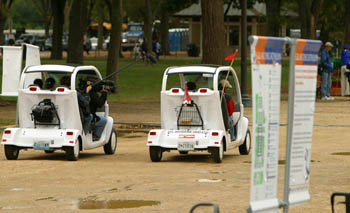
The DIY Network films Maryland students as they work to acquire points
in the Getting Around Contest.
(Credit: Stefano
Paltera, Solar Decathlon)
October 14, 2005
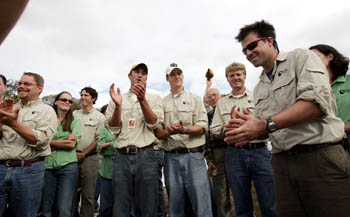
Following a seesaw battle for the number one place during the last two days of the competition, University of Colorado team members react to the announcement that they
are the winners of the 2005 Solar Decathlon.
(Credit: Stefano Paltera, Solar Decathlon)
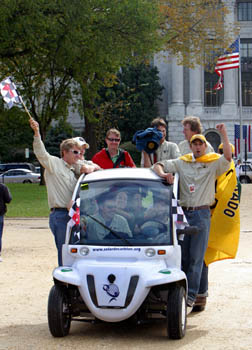
Colorado's winning strategy was to score extra points by getting the
most possible miles out of their electric car. They drove 318 miles during the competition, using a steady
foot on the accelerator and going easy on the brakes.
(Credit: Stefano Paltera, Solar
Decathlon)
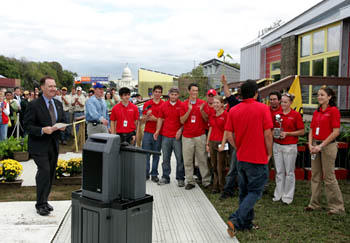
Cornell University accepts their second place overall award for the 2005
Solar Decathlon from DOE's Under Secretary of Energy David Garman.
(Credit: Stefano Paltera,
Solar Decathlon)
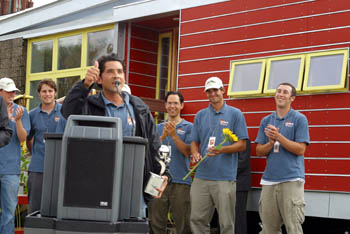
The Cal Poly team accepts their award for third place overall in the 2005
Solar Decathlon in front of Colorado's house.
(Credit: Stefano Paltera, Solar Decathlon)
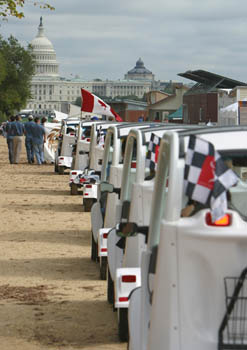
In celebration of the close of the competition, the teams take a final lap around the National Mall in
their electric vehicles. The last lap is worth five points toward the Getting Around Contest.
(Credit: Stefano Paltera, Solar
Decathlon)
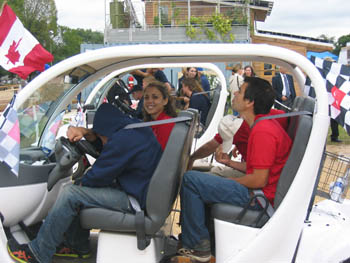
The Canadian Solar Decathlon team takes a last lap around the National
Mall. The DOE Energy Efficiency and Renewable Energy Office and the National Association of Homebuilders
recognized the team with a first-place plaque for building the most energy-efficient house. The prize also
includes sending two students to the International Builders' Show in Orlando, Florida, in January 2006.
(Credit: Virginia M. Cahill)
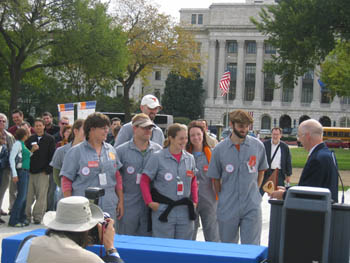
University of Texas accepts a plaque recognizing the team for building the
third most energy-efficient home at the Decathlon. Texas also scored the most points for indoor air quality and solar hot
water heating.
(Credit: Virginia M. Cahill)
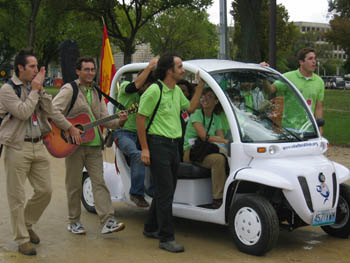
The Madrid team brings live music to the last lap.
(Credit:
Virginia M. Cahill)
October 15, 2005
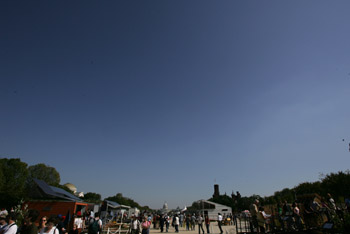
Today is the solar village's first day without rain, drizzle or fog in over a week.
(Credit:
Stefano Paltera, Solar Decathlon)
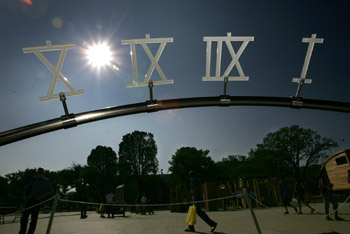
The sun dial outside the home of Universidad Politécnica de Madrid
finally cast a shadow today.
(Credit: Stefano Paltera, Solar Decathlon)
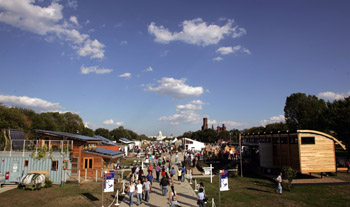
The competition is over, but public tours continue through Sunday.
(Credit: Stefano Paltera,
Solar Decathlon)
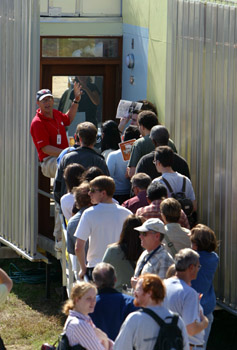
Long lines form outside Rhode Island School of Design, and all of the solar
houses, as the public takes advantage of the fine weather to explore the solar village.
(Credit:
Stefano Paltera, Solar Decathlon)
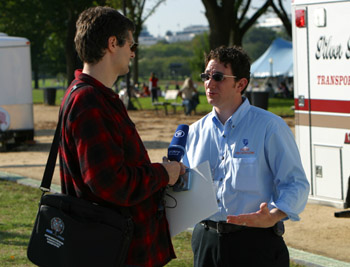
The Solar Decathlon continues to attract media attention.
(Credit: Stefano Paltera, Solar
Decathlon)
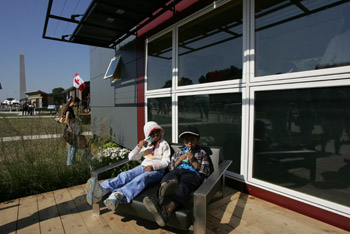
Visitors to Cal Poly take advantage of the home's sun deck for some
refreshments.
(Credit: Stefano Paltera, Solar Decathlon)
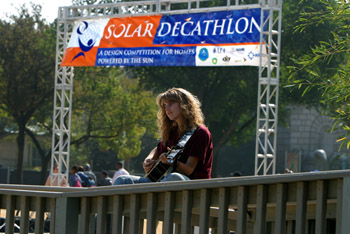
A Crowder student brings some music to people awaiting house tours.
(Credit: Stefano Paltera, Solar Decathlon)
October 16, 2005
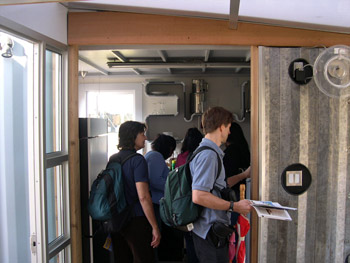
Public tours of the solar homes continue. The teams begin disassembly of their homes Sunday night.
(Credit: Richard King, Department of Energy)
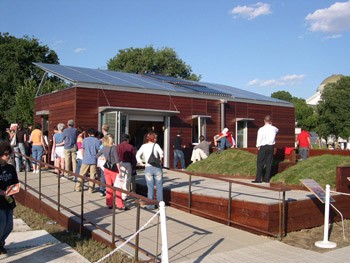
Visitors line up to see the Cornell house, the second place finisher in
the Solar Decathlon.
(Credit: Richard King, Department of Energy)
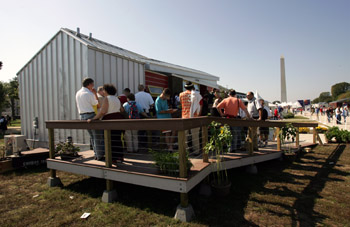
Visitors stand in line to see Colorado's house the winner of the Solar
Decathlon.
(Credit: Richard King, Department of Energy)
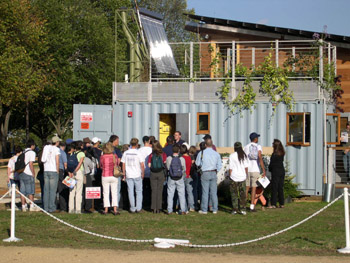
A New York Institute of Technology student explains how his team's hydrogen
fuel cell powers the NYIT house.
(Credit: Richard King, Department of Energy)
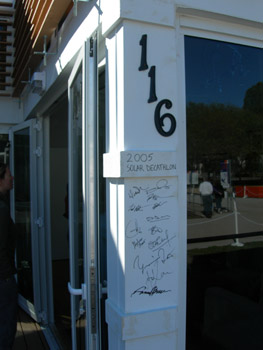
Florida International University decathletes sign their house as they
prepare for the end of their stay in Washington, DC.
(Credit: Susan Moon, NREL)

Cornell students give away their edible garden one plant at a time as
they prepare to disassemble their home.
(Credit: Ruby Nahan, NREL)
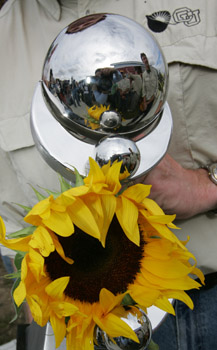
University of Colorado takes home the biggest trophy from the 2005
Decathlon.
(Credit: Stefano Paltera, Solar Decathlon)
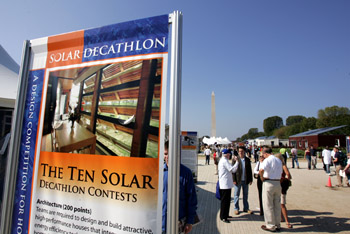
The Solar Decathlon concludes today. The next Decathlon will be held in 2007.
(Credit: Stefano
Paltera, Solar Decathlon)
